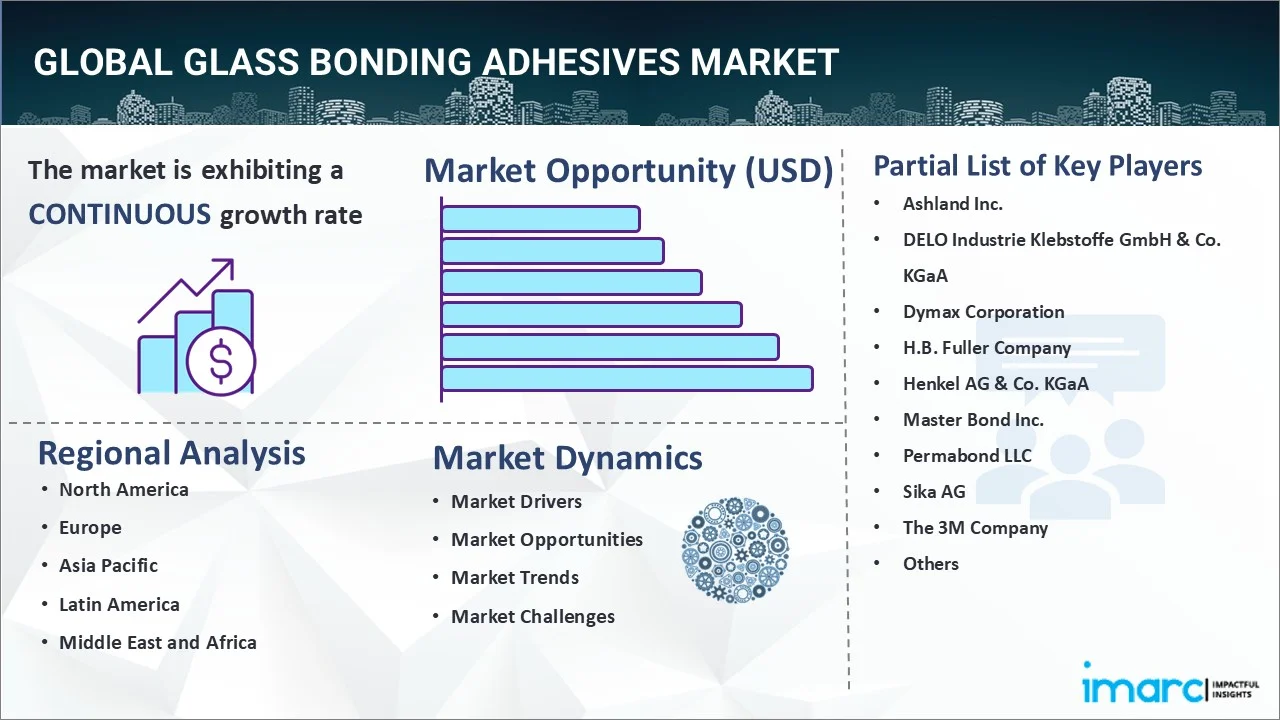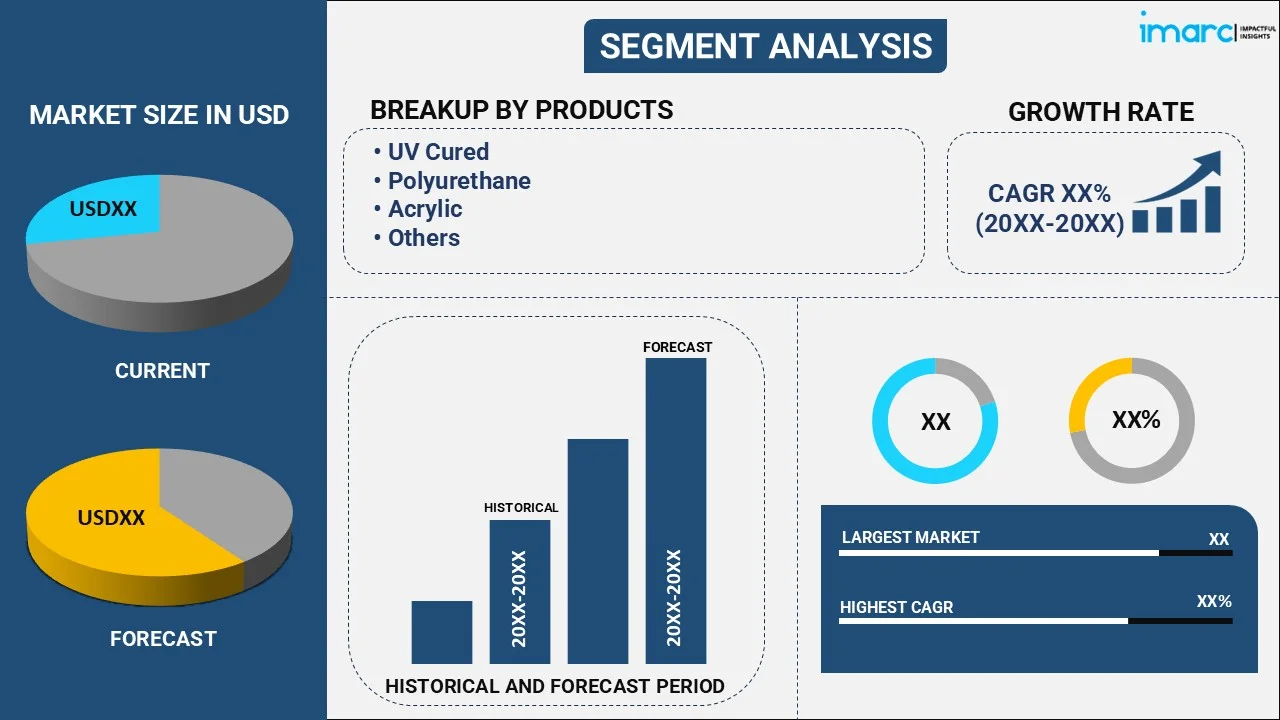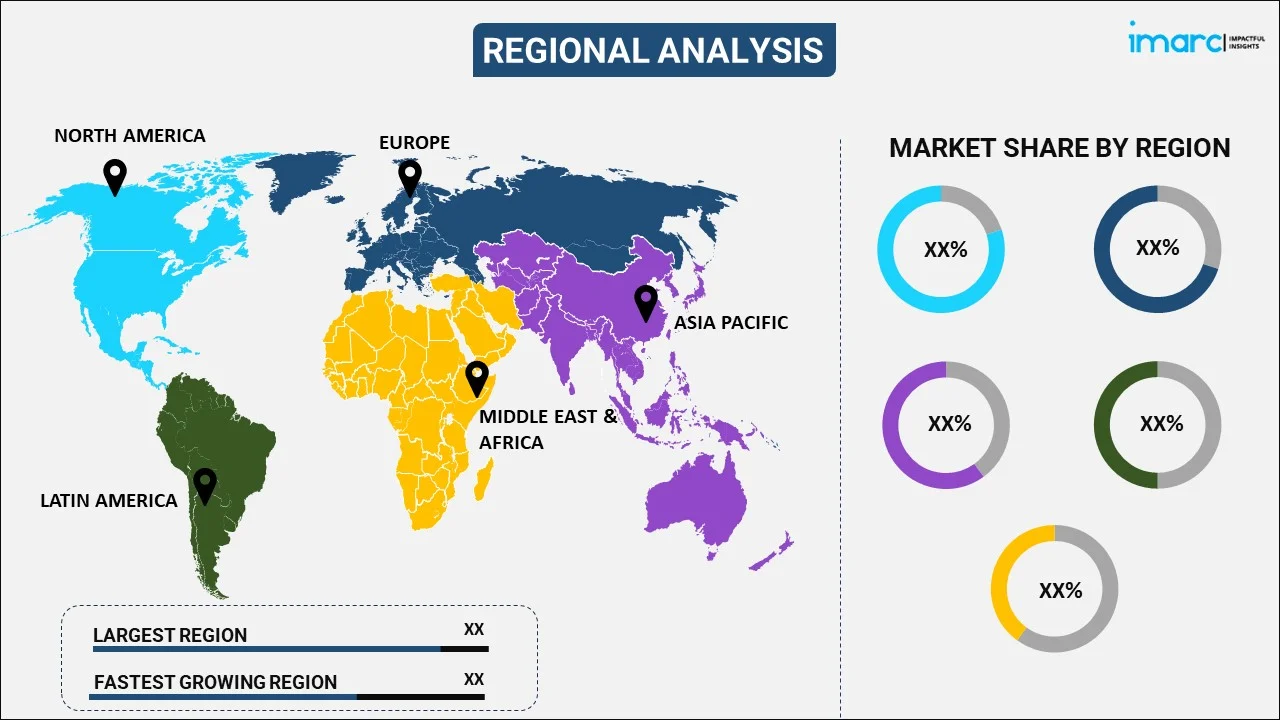
Glass Bonding Adhesives Market Report by Product (UV Cured, Polyurethane, Acrylic, Silicone, and Others), Application (Construction, Furniture, Automotive and Transportation, Electronics and Appliances, Consumer Goods, Medical Devices, and Others), and Region 2025-2033
Glass Bonding Adhesives Market Size:
The global glass bonding adhesives market size reached USD 4.1 Billion in 2024. Looking forward, IMARC Group expects the market to reach USD 6.7 Billion by 2033, exhibiting a growth rate (CAGR) of 5.66% during 2025-2033. The market is experiencing robust growth, driven by the increasing application in the automotive sector, growing demand in the electronics industry, heightened product adoption in construction and renovation projects, rapid technological advancements, and the burgeoning demand for eco-friendly and sustainable adhesive solutions in compliance with stringent environmental regulations.
|
Report Attribute
|
Key Statistics
|
|---|---|
|
Base Year
|
2024
|
|
Forecast Years
|
2025-2033
|
|
Historical Years
|
2019-2024
|
|
Market Size in 2024
|
USD 4.1 Billion |
|
Market Forecast in 2033
|
USD 6.7 Billion |
| Market Growth Rate 2025-2033 | 5.66% |
Glass Bonding Adhesives Market Analysis:
- Major Market Drivers: The market is driven by major improvements in adhesive formulations, such as hybrid and ultraviolet (UV)-cured adhesives, which provide better performance qualities. Furthermore, the growing demand for glass bonding adhesives in the transportation and automotive industries because of their strong and lightweight bonding solutions is propelling the market expansion. The rise in consumer electronics and the need for high-performance adhesives in applications like display panels and sensors is also expanding the popularity of these adhesives.
- Key Market Trends: There has been a notable trend towards the adoption of eco-friendly and sustainable adhesives, due to strict environmental legislation and corporate sustainability goals. Furthermore, the need for high-performance glass bonding adhesives is being further stimulated by the growth of electric and autonomous vehicles as well as the widespread use of sophisticated electronics.
- Geographical Trends: The Asia Pacific region dominates the market due to rapid industrialization and economic growth in countries like China, India, Japan, and South Korea. This region's robust automotive, electronics, and construction industries, along with favorable government policies and investments, contribute to its leading position. Other regions are also witnessing growth driven by technological advancements and a strong focus on sustainability.
- Competitive Landscape: Some of the major market players in the glass bonding adhesives industry include Ashland Inc., DELO Industrie Klebstoffe GmbH & Co. KGaA, Dymax Corporation, H.B. Fuller Company, Henkel AG & Co. KGaA, Master Bond Inc., Permabond LLC, Sika AG, The 3M Company, and The Dow Chemical Company, among many others.
- Challenges and Opportunities: The market confronts many obstacles, including the high price of sophisticated adhesive formulations and the need to comply with environmental regulations. However, the creation of bio-based adhesives and the rising need for smart glass technologies in a variety of applications present new opportunities for the market expansion.

Glass Bonding Adhesives Market Trends:
Growing Product Demand in the Automotive Industry
Glass bonding adhesives are used in the automotive industry, which is a major driver of this market. These adhesives have become an important feature of modern vehicle manufacturing as they enable significant weight reductions, structural stability, and design flexibility. As the automobile industry evolves, there is a growing need for new materials and technologies that improve vehicle performance, safety, and aesthetics. For instance, the number of motor cars manufactured worldwide in 2022 increased to 85.4 million, a 5.7% increase from the year before. China produced 27,222 thousand of these vehicles, Europe 16,391, and North America 14,901. This surge in car production has paralleled the usage of glass bonding adhesives, as automakers are increasingly using lightweight materials to lower the total weight of vehicles, which improves fuel economy and reduces emissions.
Increasing Applications in the Electronics Industry
The electronics sector has emerged as a prominent consumer of this product, owing to the growing usage of sophisticated glass components in different electronic gadgets. There is an upsurge in demand for high-performance adhesives that are capable of establishing strong, long-lasting, and trustworthy bindings in electronic devices. One of the most common applications of these adhesives in the electronics sector is the production of display panels. The rise of smartphones, tablets, laptops, and other consumer gadgets has resulted in increased demand for high-quality display panels. For example, the smartphone industry is predicted to increase at a rapid rate of 3.2% every year. It is expected that the market will reach 1,968.7 million units by 2032. The panels used in these smartphones often feature glass substrates that require precise and secure bonding to ensure optimal performance and durability, boosting the use of these bonding adhesives.
Growing Adoption in Construction and Architectural Applications
The expanding construction and architecture industries are a major driver of this market. The construction sector has experienced significant growth in the usage of glass for both aesthetic and practical applications, resulting in an increase in demand for innovative bonding solutions that can assure the longevity and safety of glazing installations. Architects and builders are increasingly using huge glass facades, curtain walls, and structural glazing in their projects to improve building aesthetics and energy efficiency. The building construction sector worldwide is projected to grow at a rate of 5.13% annually between 2024 and 2032. Glass bonding adhesives are essential for installing energy-efficient windows and doors. As the demand for energy-efficient buildings grows, there is a corresponding need for advanced glazing systems that can reduce heat loss, improve insulation, and enhance natural lighting.
Glass Bonding Adhesives Market Segmentation:
IMARC Group provides an analysis of the key trends in each segment of the market, along with forecasts at the global, regional, and country levels for 2025-2033. Our report has categorized the market based on product and application.
Breakup by Product:

- UV Cured
- Polyurethane
- Acrylic
- Silicone
- Others
UV cured accounts for the majority of the market share
The report has provided a detailed breakup and analysis of the market based on the product. This includes UV cured, polyurethane, acrylic, silicone, and others. According to the report, UV cured represented the largest segment.
As per the glass bonding adhesives market research and analysis, ultraviolet (UV)-cured adhesives represented the largest market due to their rapid curing times, high bonding strength, and excellent optical clarity. These adhesives cure instantly upon exposure to UV light, which significantly enhances production efficiency in industries such as electronics, automotive, and medical devices. Moreover, their ability to provide robust adhesion without the need for heat or solvents, thus making them ideal for delicate and temperature-sensitive applications, is bolstering the glass bonding adhesives market value and revenue. Additionally, UV-cured adhesives are highly resistant to environmental factors such as moisture, temperature fluctuations, and chemicals, ensuring the longevity and reliability of bonded components.
Breakup by Application:
- Construction
- Furniture
- Automotive and Transportation
- Electronics and Appliances
- Consumer Goods
- Medical Devices
- Others
Automotive and transportation holds the largest share of the industry
A detailed breakup and analysis of the market based on the application have also been provided in the report. This includes construction, furniture, automotive and transportation, electronics and appliances, consumer goods, medical devices, and others. According to the report, automotive and transportation accounted for the largest market share.
Based on the glass bonding adhesives market outlook and forecast, the automotive and transportation sectors accounted for the largest market share. The dominance of this segment is driven by the increasing demand for lightweight, durable, and aesthetically appealing vehicles. Glass bonding adhesives are crucial in automotive manufacturing for applications such as bonding windshields, windows, sunroofs, and other glass components to the vehicle structure. Their rising ability to provide strong and durable bonds that enhance vehicle safety, structural integrity, and performance while allowing for innovative design flexibility is promoting the glass bonding adhesive market share.
Breakup by Region:

- North America
- United States
- Canada
- Asia-Pacific
- China
- Japan
- India
- South Korea
- Australia
- Indonesia
- Others
- Europe
- Germany
- France
- United Kingdom
- Italy
- Spain
- Russia
- Others
- Latin America
- Brazil
- Mexico
- Others
- Middle East and Africa
Asia Pacific leads the market, accounting for the largest glass bonding adhesives market share
The report has also provided a comprehensive analysis of all the major regional markets, which include North America (the United States and Canada); Asia Pacific (China, Japan, India, South Korea, Australia, Indonesia, and others); Europe (Germany, France, the United Kingdom, Italy, Spain, Russia, and others); Latin America (Brazil, Mexico, and others); and the Middle East and Africa. According to the report, Asia Pacific represents the largest regional market for glass bonding adhesives.
According to the glass bonding adhesives market overview, Asia Pacific represented the largest market share. This dominance is attributed to the rapid industrialization, urbanization, and economic growth in countries such as China, India, Japan, and South Korea. Moreover, the robust growth of the automotive, electronics, and construction industries in the region, driving the demand for high-performance adhesives, is favoring the market growth. Along with this, the increasing production of consumer electronics, the expansion of the automotive sector with a focus on lightweight and fuel-efficient vehicles, and the surge in construction activities are contributing to the glass bonding adhesives market growth and scope.
Competitive Landscape:
- The market research report has also provided a comprehensive analysis of the competitive landscape in the market. Detailed profiles of all major companies have also been provided. Some of the major market players in the glass bonding adhesives industry include Ashland Inc., DELO Industrie Klebstoffe GmbH & Co. KGaA, Dymax Corporation, H.B. Fuller Company, Henkel AG & Co. KGaA, Master Bond Inc., Permabond LLC, Sika AG, The 3M Company, The Dow Chemical Company, etc.
(Please note that this is only a partial list of the key players, and the complete list is provided in the report.)
- The major players in the market are actively engaged in strategic initiatives to strengthen their market position and expand their product offerings. They are focusing on research and development (R&D) to innovate and enhance the performance of their adhesive products. These innovations include the development of advanced UV-cured and hybrid adhesives that offer superior bonding strength, faster curing times, and improved environmental resistance. Additionally, these key players are expanding their geographical footprint through acquisitions, partnerships, and the establishment of new production facilities in high-growth regions. They are also investing in sustainability initiatives by developing eco-friendly and low-volatile organic compound (VOC) adhesive formulations to comply with stringent environmental regulations and meet the growing demand for sustainable solutions. Furthermore, major companies are forming strategic collaborations with automotive, electronics, and construction industry leaders to co-develop specialized adhesives tailored to specific applications, thereby increasing the glass bonding adhesives demand.
Glass Bonding Adhesives Market News:
- In May 2024, H.B. Fuller Company announced that it has acquired ND Industries Inc., a leading provider of specialty adhesives and fastener locking and sealing solutions that served customers in the automotive, electronics, aerospace, and other industries. As part of the acquisition, products under ND Industries’ Vibra-Tite brand will be added to H.B. Fuller’s existing epoxy, cyanoacrylate, UV curable and anaerobic product range.
- In February 2024, Henkel introduced two next-generation medical grade, cyanoacrylates-based instant adhesives that offer improved safety and performance, Loctite 4011S and Loctite 4061S. The new products are formulated without carcinogenic, mutagenic or reproductively hazardous (CMR) ingredients and are designed to offer increased strength during and after heat cycling. Loctite 4011S and Loctite 4061S are designed to meet the specifications of Loctite 4011 and 4061 for easier validation in existing medical applications.
Glass Bonding Adhesives Market Report Scope:
| Report Features | Details |
|---|---|
| Base Year of the Analysis | 2024 |
| Historical Period | 2019-2024 |
| Forecast Period | 2025-2033 |
| Units | Billion USD |
| Scope of the Report | Exploration of Historical Trends and Market Outlook, Industry Catalysts and Challenges, Segment-Wise Historical and Future Market Assessment:
|
| Products Covered | UV Cured, Polyurethane, Acrylic, Silicone, Others |
| Applications Covered | Construction, Furniture, Automotive and Transportation, Electronics and Appliances, Consumer Goods, Medical Devices, Others |
| Regions Covered | Asia Pacific, Europe, North America, Latin America, Middle East and Africa |
| Countries Covered | United States, Canada, Germany, France, United Kingdom, Italy, Spain, Russia, China, Japan, India, South Korea, Australia, Indonesia, Brazil, Mexico |
| Companies Covered | Ashland Inc., DELO Industrie Klebstoffe GmbH & Co. KGaA, Dymax Corporation, H.B. Fuller Company, Henkel AG & Co. KGaA, Master Bond Inc., Permabond LLC, Sika AG, The 3M Company, The Dow Chemical Company, etc. |
| Customization Scope | 10% Free Customization |
| Post-Sale Analyst Support | 10-12 Weeks |
| Delivery Format | PDF and Excel through Email (We can also provide the editable version of the report in PPT/Word format on special request) |
Key Benefits for Stakeholders:
- IMARC’s industry report offers a comprehensive quantitative analysis of various market segments, historical and current market trends, market forecasts, and dynamics of the glass bonding adhesives market from 2019-2033.
- The research report provides the latest information on the market drivers, challenges, and opportunities in the global glass bonding adhesives market.
- The study maps the leading, as well as the fastest-growing, regional markets. It further enables stakeholders to identify the key country-level markets within each region.
- Porter's five forces analysis assists stakeholders in assessing the impact of new entrants, competitive rivalry, supplier power, buyer power, and the threat of substitution. It helps stakeholders to analyze the level of competition within the glass bonding adhesives industry and its attractiveness.
- The competitive landscape allows stakeholders to understand their competitive environment and provides insight into the current positions of key players in the market.
Key Questions Answered in This Report
We expect the global glass bonding adhesives market to exhibit a CAGR of 5.66% during 2025-2033.
The rising demand for glass bonding adhesives across numerous end-use industries, such as construction, furniture, electronics, etc., owing to its easy application, high strength bond and adhesion, and resistance to low temperature properties, is primarily driving the global glass bonding adhesives market.
The sudden outbreak of the COVID-19 pandemic had led to the implementation of stringent lockdown regulations across several nations resulting in temporary closure of numerous end-use industries for glass bonding adhesives.
Based on the product, the global glass bonding adhesives market has been divided into UV cured, polyurethane, acrylic, silicone, and others. Among these, UV cured currently exhibits a clear dominance in the market.
Based on the application, the global glass bonding adhesives market can be categorized into construction, furniture, automotive and transportation, electronics and appliances, consumer goods, medical devices, and others. Currently, the automotive and transportation sector accounts for the majority of the global market share.
On a regional level, the market has been classified into North America, Asia-Pacific, Europe, Latin America, and Middle East and Africa, where Asia-Pacific currently dominates the global market.
Some of the major players in the global glass bonding adhesives market include Ashland Inc., DELO Industrie Klebstoffe GmbH & Co. KGaA, Dymax Corporation, H.B. Fuller Company, Henkel AG & Co. KGaA, Master Bond Inc., Permabond LLC, Sika AG, The 3M Company, and The Dow Chemical Company.
Need more help?
- Speak to our experienced analysts for insights on the current market scenarios.
- Include additional segments and countries to customize the report as per your requirement.
- Gain an unparalleled competitive advantage in your domain by understanding how to utilize the report and positively impacting your operations and revenue.
- For further assistance, please connect with our analysts.
 Request Customization
Request Customization
 Speak to an Analyst
Speak to an Analyst
 Request Brochure
Request Brochure
 Inquire Before Buying
Inquire Before Buying




.webp)




.webp)












